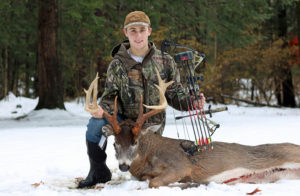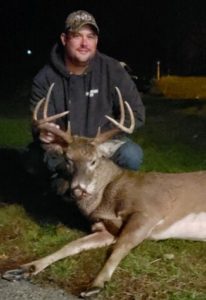Seventeen-year old Richard (Ricky) Armstrong III of Lenox had a memorable day of deer hunting on Monday, November 19. While archery hunting in Lenox after school, he dropped a 10- point, 215lbs buck. The deer was weighed by Ricky and his dad Richard Jr. on new scales purchased from Cabela’s. (During Archery Hunting season, deer can be checked in on-line without having to take them to official deer weighing/checking stations).
There is an interesting story as to how he was able to come across such a magnificent deer. On the previous Saturday afternoon his buddy, Luke Patella, saw the deer in his back yard. He told Ricky about it and sent a picture of it. On Sunday afternoon, Ricky walked and drove around looking for the tracks of the deer in the snow to find out where it crossed and where it might be. During the past summer, he knew where the deer usually bedded down in a nearby thick patch of woods.
On Monday afternoon, after school, he went after the big buck. He set up around 3:00 pm near one of the deer trails that comes out of the thick patch. He chose to hunt off of the ground rather than to use a tree stand. At about 3:15 two does and the buck came down the trail near him and when the buck was about 15 yards away, he let an arrow fly. He knew he hit the buck pretty good and expected it to run away, but it just stood there. Ricky reached back behind him to get another arrow out of the quiver and when he looked back, the deer took a couple of steps and fell over.
Based upon the picture that Luke had previously sent him, Ricky knew it was a big deer. But not that big!
Getting the deer out of the woods was not much of a problem according to his dad, Richard Jr., because there was snow on the ground. They were able to put it in a sled and drag it out fairly easily.
Ricky is going to have the deer head mounted by taxidermist Dave Berger of Wild Arts Taxidermy Studio in Berlin, CT. The “green” or rough score of the antlers was 167 3/8 total inches and the spread was 22 inches as determined by the Northeast Big Buck Club. The Pope and Young Club will also measure it. (The Pope & Young Club is recognized as the official repository for records on bow-harvested North American big game. The Northeast Big Buck Association also provides scoring and record-keeping services). Ricky will have to wait 60 days for the antlers to dry before getting the final official score.
His dad said that when Ricky got the deer he was shaking with excitement. He said that everyone who learned about it was excited about Ricky’s feat because of his age and the fact that there are not as many youths involved in the outdoors today as there once was. He said that fortunately he has three sons all into hunting and fishing.
Ricky III is at least a 4th generation family deer hunter. His great grandfather Richard, was a hunter, as were his grandfather (also known as Ricky) and his great uncle (Billy). I went to school with them and remember them as being avid outdoor sportsmen. Both of them have since passed over the ridge but I would bet that they would be very proud of young Ricky today. Ricky’s father, Richard Jr. is a hunter as is his uncle Harold – hunting is an age-old tradition in this family. (Incidentally, I went to school with young Ricky’s grandma Nancy, too, but I don’t think she hunts.)
Other big deer were harvested during the Archery season
The final archery deer hunting results have not yet been released, but we do know that other large deer have been harvested in the Berkshires. For example, Robert Zieba of North Adams took a 199lbs, 11-point buck in Savoy. It was weighed on a certified DFW scale. Brian Bishop of Adams took a 204lbs, 8-point buck in Adams, Michael Kinna of Egremont took a 200lbs, 7- point buck in Egremont, and Matt Zamboni of Lee took a 205lbs, 8-point buck in Lee. 
Incidentally, Matt is having quite a year of hunting. During the bear hunting season, he took a 342lbs bear (dressed weight) in Otis. Let’s hope he has a large freezer.
Commonwealth to give River and Wetland Restoration Grants
Some $188,600 will be issued for river and wetland restoration projects in Falmouth, Northampton/Easthampton, North Adams, and Plymouth through the Department of Fish and Game’s Division of Ecological Restoration’s Priority Projects Program. The program provides projects with grant funding, project management, and contracted technical services for wetland and river restoration, urban river revitalization, and streamflow restoration projects that present the greatest benefit to the Commonwealth, ecologically, socially, and economically.
The five projects help local partners remove aging dams, restore a floodplain forest, rejuvenate historic wetlands on retired cranberry bogs, revitalize an urban river and leverage $3 million in federal and private funding. The projects will restore river habitat for river herring and eastern brook trout, wetland habitat for several rare plant and animal species, and increase municipal resilience to climate change.
“Removal of unwanted dams, upgrading undersized culverts and restoration of floodplain and wetland habitat benefits the environment and helps communities adapt to climate change,” said Energy and Environmental Affairs Secretary Matthew Beaton. “We look forward to working with the communities receiving Priority Project funding to protect and restore these wetlands and rivers and increase biodiversity across the state.”
“These projects improve fish and wildlife habitat, increase resilience to severe weather events, and further protect public safety,” said Department of Fish and Game Commissioner Ronald Amidon. “They benefit a number of fish and wildlife species throughout the Commonwealth, including eastern brook trout, river herring, and waterfowl.”
Priority Projects are evaluated by DER on their ecological benefit, feasibility, contribution to climate readiness, opportunity for public education and recreation, available program resources, and partner support. They are chosen through a statewide, competitive process.
One of those grants is earmarked for the Hoosic River Flood Chute Naturalization Project in North Adams. The City of North Adams, The Hoosic River Revival, The Hoosic River Watershed Association, and state and federal agencies are working together to re-naturalize and revitalize the North and South Branches of the Hoosic River as the rivers flow through North Adams.
The project will improve public safety, reduce annual operating and maintenance costs while improving habitat, access, connectivity and climate resilience. This phase of the project includes the design and permitting of a flood management system within North Adams to replace the existing 2.5 mile concrete chute system, an aging structure that has outlived its design life.
The Hoosic River, one of the few remaining mainstem cold water fishery resources in the Commonwealth, supports a viable wild brook trout population on both branches of the Hoosic River upstream of the city. The funding will be used to build local capacity to advance the project, negotiation for land-sharing of the Phase 1 project area and community outreach around the goals of the project. The grant is matched 2:1 through private funders.

